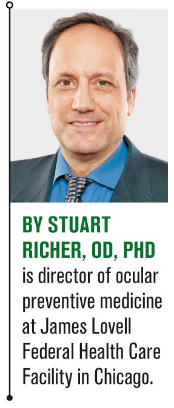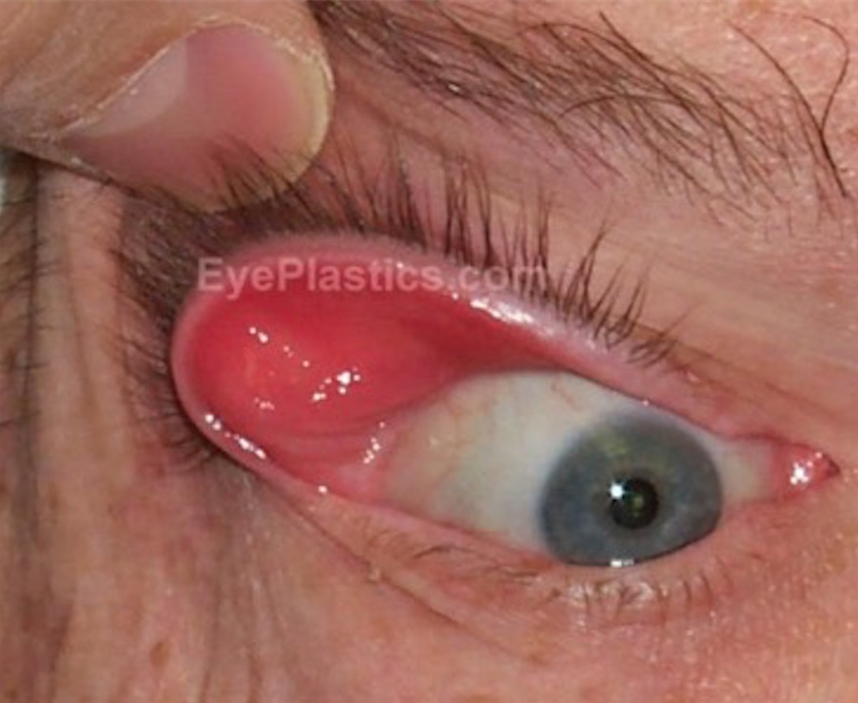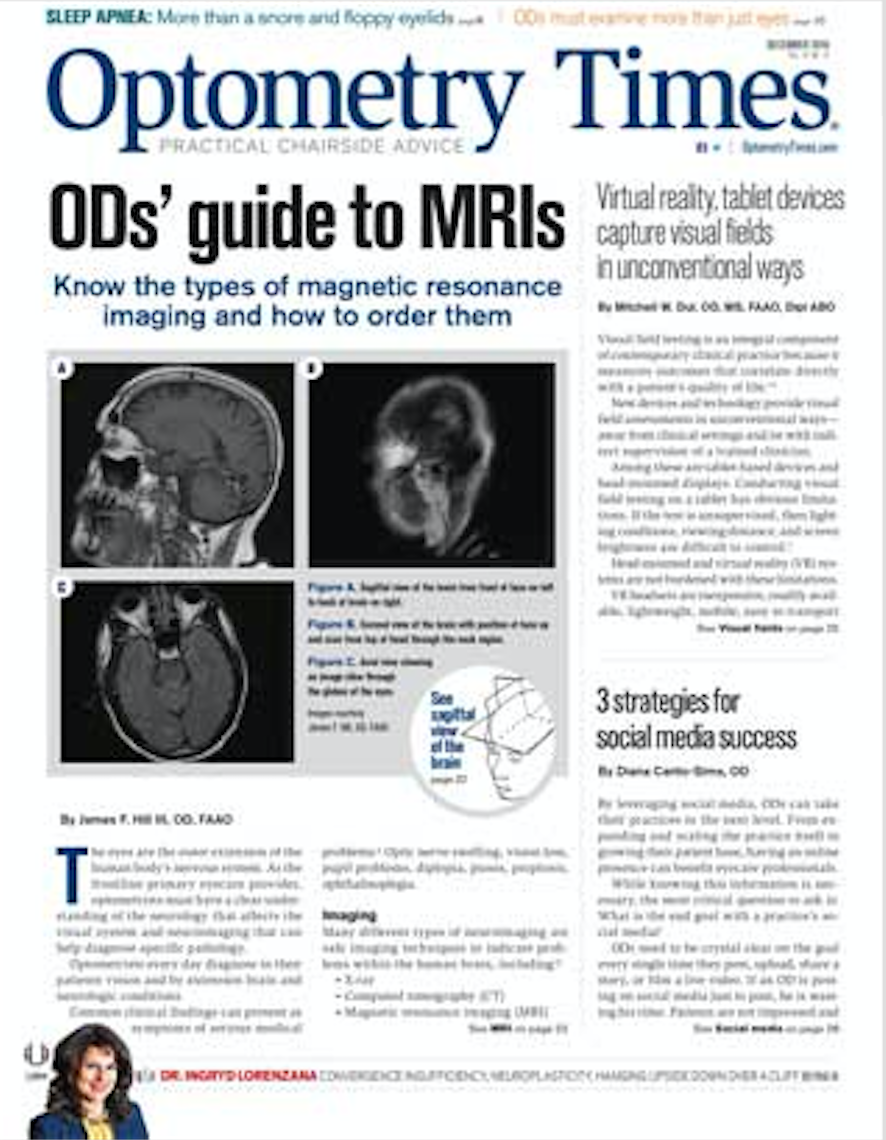Sleep apnea: More than a snore and floppy eyelids


Relative to non-OSAS subjects, OSAS subjects have four times higher odds of floppy eyelid syndrome.

Some 18 million Americans suffer from obstructive sleep apnea syndrome (OSAS) while attempting to get a restful night of sleep.
While it is most common in overweight African or Latino-American males and their families, it occurs in all ethnicities, genders (2 percent women, 4 percent men), and ages-including infants and children.1
Patients can be afflicted with OSAS and not be aware of the risk to their overall health. That is where clinical optometry comes in, especially for a patient who is falling asleep during an OD’s refraction.
About OSAS
OSAS occurs in anatomically predisposed individuals when their tongues, or other soft tissues of their palates, obstructs or flops over their airways while sleeping.2
This blockage of breathing (and diminished blood oxygen called apnea hypopnea) can last 10 to 30 seconds and repeat several hundred times during the night.
Typically, normal breathing starts again, sometimes with a loud snort or choking sound. The patient is ultimately left with mild or severe chronic exhaustion.
Related: How sleep apnea affects the eye
A second, far less common non-obstructive apnea called central sleep apnea occurs when the brain doesn’t synchronize with the breath cycle. Paradoxically, patients who attempt to self–treat these conditions with alcohol, sleeping pills, antidepressants, benzodiazepines or narcotics, actually worsen their conditions.
OSAS disrupts every aspect of a patient’s life. At a minimum, the patient will be fatigued during an eye examination. At worst, OSAS heightens the patient’s risk of hypertension, heart attack, atrial fibrillation, car accidents, job-related injuries and-ominously-stroke and vascular dementia.3
OSAS also impacts the diagnosis and successful treatment of common eye diseases.2
Ocular disease impact
OSAS approximately doubles the risk of most ocular-vascular diseases, including low-tension glaucoma, and is extremely common in non-arteritic ischemic optic neuropathy (NAION).4
This is especially true for patients with a low ocular perfusion pressure below 50 mm Hg, estimated by subtracting their IOP from their diastolic blood pressure. It plays a role in central serous retinopathy, central retinal vein occlusion, and notably increases the risk of NAION by a factor of six times.5
Discern and refer
ODs noticing sleeping disturbances in their patients should refer them for a comprehensive sleep evaluation by physicians certified in sleep medicine, typically within a sleep clinic.
These facilities provide evaluation of sleep disorders following high-tech overnight polysomnography. This medical assessment employs multiple physiologic sensors, such as pulse oximetry, the electrocardiogram, respiration, sounds, and erectile response.
Related: How sleep affects the ocular surface
Sleep studies often uncover the root cause of restless leg syndrome, narcolepsy, cataplexy, sleep paralysis, hallucinations, sleepwalking, sleep deprivation, and even sleep-related eating disorders and violence.
Therapy often results in prescription of a continuous positive airway pressure (CPAP) machine, a bilevel positive airway pressure (BiPAP) machine, or even a dental mouth guard. Commercial units are getting smaller, quieter, and simpler to use.
CPAP patients often experience dry eyes and can be assisted with lubrication and specialized moisture rich sealing nighttime eyewear (EyeSeals, EyeEco).
ODs are also addressing two other sleep-related concerns-nocturnal lagophthalmos and recurrent corneal erosions-which represent a third sleep-related practice proficiency area.
Responsibility and opportunity
In order to save lives and eyes, ODs are teaching students and residents to query their patients about total sleep time and total sleep quality while looking for characteristic facial features such as floppy eyelids and wide neck.
We recognize OSAS as a common comorbidity in patients with LTG and NAION.
Because there is no widely accepted, evidence–based treatment for NAION, prevention is key for protecting patients.
OSAS is also associated with excessive and worsened outcomes with anti-VEGF treatment of patients with advanced diabetic retinopathy.6,7
People with obstructive sleep apnea had a longer course of diabetes mellitus (P<0.01) and a higher prevalence of retinopathy (P<0.01), neuropathy (P=0.05), cardiovascular disease (P<0.01), and hypertension (P<0.01).6
OSAS is critically important in efficacious treatment of advanced age-related macular degeneration with anti-VEGF agents by retinal specialists. In one study, the treated OSAS group received only 8±7 total injections, while the untreated OSAS group received 16±4 injections (P<0.05).8
Sleep-disordered breathing in children is associated with inattention, impulsivity and hyperactivity.9
Prior to referral to a sleep clinic physician, ODs should encourage patients to take strategic naps to avoid car accidents until fully treated.
Read more by Stuart Richer, OD, PhD
References:
1. Maspero C, Giannini L, Galbiati G, Rosso G, Farronato G. Obstructive sleep apnea syndrome: a literature review. Minerva Stomatol. 2015 Apr; 64(2):97-109.
2. Huon LK , Liu SY, Camacho M , Guilleminault C. The association between ophthalmologic diseases and obstructive sleep apnea: a systematic review and meta-analysis. Sleep Breath. 2016 Dec 20(4): 1145-1154.
3. Culebras A, Anwar S. Sleep apnea is a risk factor for stroke and vascular dementia. Curr Neurol Neurosci Rep. 2018 Jun 25;18(8):53. doi: 10.1007/s11910-018-0855-1.
4. Bilgin, G. Normal-tension glaucoma and obstructive sleep apnea syndrome: a prospective study. BMC Ophthalmol. 2014 Mar 10; 1471-2415-14-27.
5. Wu Y, Zhou LM, Lou H, Cheng JW, Wei RL. The association between OSA obstructive sleep apnea and nonarteritic anterior ischemic optic neuropathy: a systematic review and meta-analysis. Curr Eye Res. 2016 Jul;41(7):987-92.
6. Manin G, Pons A, Baltzinger P, Moreau F, Iamandi C, Wilhelm JM, Lenoble P, Kessler L, Kessler R. Obstructive sleep apnoea in people with Type 1 diabetes: prevalence and association with micro- and macrovascular complications. Diabetic Med. 2015 Jan;32(1):90-6.
7. Leong WB, Jadhakhan F, Taheri S, Chen YF, Adab P, Thomas GN. Effect of obstructive sleep apnoea on diabetic retinopathy and maculopathy: a systematic review and meta-analysis. Diabet Med. 2016 Feb;33(2):158-68.
8. Schaal, Sherman MP, Nesmith B, Barak Y. Untreated obstructive sleep apnea hinders response to bevacizumab in age-related macular degeneration. Retina. 2016 Apr;36(4):791-7.
9. Smith DL, Gozal D, Hunter SJ, Philby MF, Kaylegian J, Kheirandish-Gozal L. Impact of sleep disordered breathing on behaviour among elementary school-aged children: a cross-sectional analysis of a large community-based sample. Eur Respir J. 2016 Sep 1.

Newsletter
Want more insights like this? Subscribe to Optometry Times and get clinical pearls and practice tips delivered straight to your inbox.